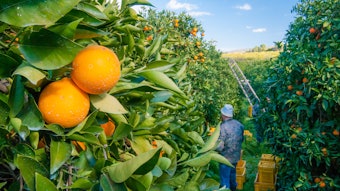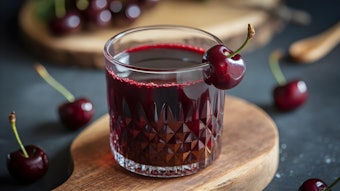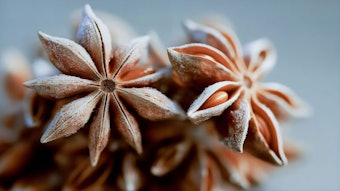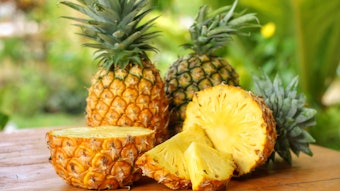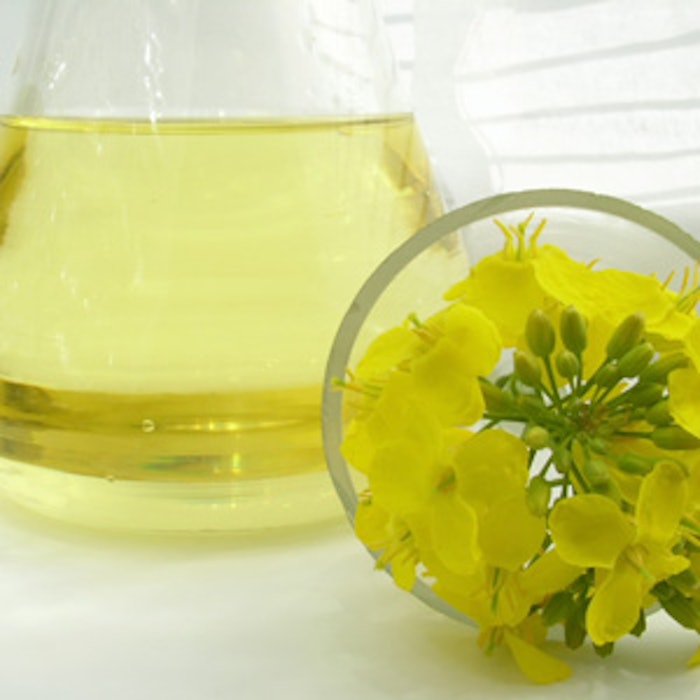
This month’s column by Judith Michalski features the live Flavorcon panelists and session held on November 15, 2015. Ingredients described include: veratraldehyde, natural; 2-acetylpyrazine, natural; γ-decalactone, natural (for more on this material, see Wright); ethyl vanillin, natural; immortelle extract (Helychrysum augustifolium DC); 3-(methylthio)decanal; 2-pentylthiophene; 1-(2-furfurylthio)propanone; and ethyl cis-4,7-octadienoate.
Listing describe applications for the given ingredients. For example, veratraldehyde, natural is suggested in: vanilla, almond, peanut, maple, strawberry, cherry, cream soda, seedy notes in berries, nut skin notes, oaky/cask notes, sweet dairy and brown flavors, among others.
Normally for each material, only common descriptors are listed. For this issue, however, all remarks have been included to show the full range of perceptions from the panel and audience. Common descriptors and applications are highlighted in boldface.
Veratraldehyde, natural
Source: The Lermond Company
FEMA# 3109, CAS# 120-14-09, natural
Natural occurrence: Vanilla, raspberry, tobacco and peppermint.
Odor: @ 1%. Sweet, vanillinlike, woody, creamy, smoky, chocolatelike, spicy, slightly brown, toasted, haylike, nut skins, floral, heliotropinelike, musky and powdery.
Taste: @ 100 ppm. Sweet, creamy, woody, spicy and brown.
Possible applications: Comments regarding where this material could be used were mostly in: vanilla, almond, peanut, maple, strawberry, cherry, cream soda, seedy notes in berries, nut skin notes, oaky/cask notes, sweet dairy and brown flavors. This material will also be very useful in TTB flavors to augment vanillin and ethyl vanillin.
The Lermond Company; www.lermond.com
2-Acetylpyrazine, natural
Source: Xiamen Bestally Biotechnology Co., Ltd.
FEMA# 3126, CAS# 22047-25-2, natural
Natural occurrence: Popcorn, bread, peanut and cocoa.
Odor: @ 1%. Sweet, ricelike, popcornlike, corn chiplike, fried, bready, brown, grilled cornlike, toasted, tortillalike, nutty, brown, toasted grainlike, salty, slightly savory, dry and earthy.
Taste: @ 5 ppm. Cornlike, popcornlike, creamy, cooked butterlike, fatty, nutty, peanutlike, mushroomlike, mash, toasted, tortilla, toasted grainlike, salty, basmati ricelike.
Possible applications: Suggestions for this product were primarily in brown flavors like popcorn, sesame, peanut, taco, bread crust, grilled corn, bread, tortilla chip and pecan, as well as for adding roasted/toasted/fried/baked notes. Other flavors mentioned were browned butter, roasted peppers, grilled vegetables and pandan leaf.
Xiamen Bestally Biotechnology Co., Ltd.; www.bestally.com.cn
γ-Decalactone, natural
Source: Natural Advantage
FEMA# 2360, CAS# 706-14-9, natural
Natural occurrence: Apricot, beer, butter and tobacco.
Odor: @ 1%. Sweet, fruity, fatty, oily, “fuzzy,” peachlike, apricotlike, creamy, dairy, buttery, waxy, coconutlike, and buttery.
Taste: @ 5 ppm. Peachlike, creamy, sweet, fatty, waxy.
Possible applications: This lactone straddles the divide between fruity and dairy. A wide range of flavor types were proposed for this lactone: peach, apricot, butter, butterscotch, milk, cilantro, cucumber, guava, pina colada, mango, passion fruit, cheddar cheese and cream.
Natural Advantage; www.natural-advantage.net
Ethyl vanillin, natural
Source: Aurochemicals
FEMA# 2464, CAS# 121-32-4, natural
Natural occurrence: This material generally is accepted as not occurring in nature but it has been tentatively identified in certain vanilla species, specifically pompon, tahitensis and fragrans. This has yet to be confirmed.
Odor: @ 1%. Sweet, creamy, vanilla, woody, caramellic, strong, vanillinlike.
Taste: @ 0.5 ppm. Sweet, creamy, rich, vanillinlike, slightly dairylike, vanillalike, woody and marshmallowlike.
Possible applications: Anywhere vanillin is used, ethyl vanillin can be used—albeit at about half the level. This material’s potential for use in natural flavors is interesting because two schools of thought exist regarding what’s natural. The purist may feel it should not be used, since its occurrence in nature has not been confirmed. Others will argue it is produced from natural materials, so it can be used. Time will tell.
Aurochemicals; www.aurochemicals.com
Immortelle extract (Helychrysum augustifolium DC)
Source: Robertet
FEMA# 2592, CAS# 8023-95-8, natural, Helichrysum augustifolium
Odor: @1%. Sweet, winey, dried-fruity, “bitter,” incenselike, seaweedlike, woody, earthy or slightly earthy, fenugreeklike, balsamic, slightly leatherlike, phenolic, brown, grapelike, tobaccolike, prune, jammy, musty, mushroom and oaky/casklike.
Taste: @ 5 ppm. Earthy, green, mushroom, drying, bitter, astringent, woody, grapefruitlike, red grapelike, medicinal, warm, leatherlike, haylike, incenselike, phenolic, slightly boronialike and tingling.
Possible applications: With so many descriptors for this complex material, it’s not surprising that suggested applications for it were all over and across the board; liqueurs, berries, spices, bacon, tea, cask notes, dried fruit, maple, prune, molasses, raisin, vanilla, red wine, port, red grape, grapefruit, hazelnut and general fruit and brown flavors.
Robertet; www.robertet.com
3-(Methylthio)decanal
Source: Sigma-Aldrich
FEMA# 4734, CAS# 1256932-15-6
Not yet found in nature.
Odor: @ 1%. Aldehydic, creamy, dairylike, buttery, oily, cooked cabbagelike, waxy, citrus, green, fatty, sour, rotten vegetablelike, savory, picklelike, juicy, greasy, gassy and fried meatlike.
Taste: @ 2 ppm. Fatty, gassy, fried meatlike, savory, cold fatlike, beefy, slightly green, cilantrolike, citruslike, vegetablelike, waxy, sulfurous, cooling, creamy, orangelike and peely.
Possible applications: The panelist felt this predominantly savory component would find use in dairy, fat replacer and fried-type flavors, as well as grapefruit, lemon, lime, cilantro, kimchi, salsa, beef, chicken and pork flavors.
Sigma-Aldrich; www.safcsupplysolutions.com
2-Pentylthiophene
Source: Treatt
FEMA# 4387, CAS# 4861-58-9
Natural occurrence: Chicken, soybean and cranberry.
Odor: @ 1%. Sharp, green, slightly metallic, wasabilike, fruity, fatty, roasted, green beanlike, slightly berrylike, green tealike, earthy, slightly waxy, earthy, musty, peanutlike, sweet, herbal, cooling and aniselike.
Taste: @ 1 ppm. Herbal, licoricelike, chamomilelike, earthy, plastic, root beerlike, fruity, fatty, roasted, longanlike, green beanlike, green tealike, green, leafy, bitter, wasabilike and vegetablelike.
Possible applications: This is another material that had a wide range of perceptions, and just as broad a spectrum of applications. Recommendations for its use were vegetable, cranberry, green tea, miso, root beer, mushroom, beet, tropical fruit, broccoli, wasabi, horseradish, cabbage, mango, pineapple, roast beef, green bean, roast chicken, beef and pork, tea, peanut and mint flavors.
Treatt; www.treatt.com
1-(2-Furfurylthio)propanone
Source: Charkit
FEMA# 4676, CAS# 58066-86-7
Not yet found in nature.
Odor: @ 1%. Roasted, meaty, beefy, brown, alliaceous, roast coffee, burnt popcorn, savory, liverwurst, fried onion and porklike.
Taste: @ 3 ppm. Alliaceous, roasted, beefy, savory, corn chiplike, onionlike, bloody, cruciferous, roast coffee, burnt, meaty and smoky.
Possible applications: The roasted, savory qualities of this chemical were deemed most worthy for use in dark roast coffee, roast beef, BBQ, charcoal grill-type, roast pork, fried onion, gravy, broccoli, cauliflower, Brussels sprouts and even chocolate and mocha flavors, although at miniscule levels.
Charkit; www.charkit.com
Ethyl cis-4,7-octadienoate
Source: DeLong Chemicals
FEMA# 3682, CAS# 69925-33-3
Natural occurrence: Passion fruit.
Odor: @ 1%. Sweet, green, fruity, tart, slightly citruslike, waxy, slightly floral, metallic, winey, watermelon, green, berrylike and pearlike.
Taste: @ 3 ppm. Fruity, green, unripe, fresh, metallic, waxy, berrylike, slightly citruslike and tropical, pineapple, cognac and whiskey.
Possible applications: This slimmer cousin of pear ester (FEMA# 3682) was recommended by the panel et al. for use in apple, pear (especially Bartlett), melon, honeydew melon, watermelon, guava, kiwi, dark berries like blackberry and blueberry, tropical fruits, raspberry, passion fruit, citrus blends, pineapple, cognac, whiskey and bourbon.
DeLong Chemicals; www.delongchemicals.com

